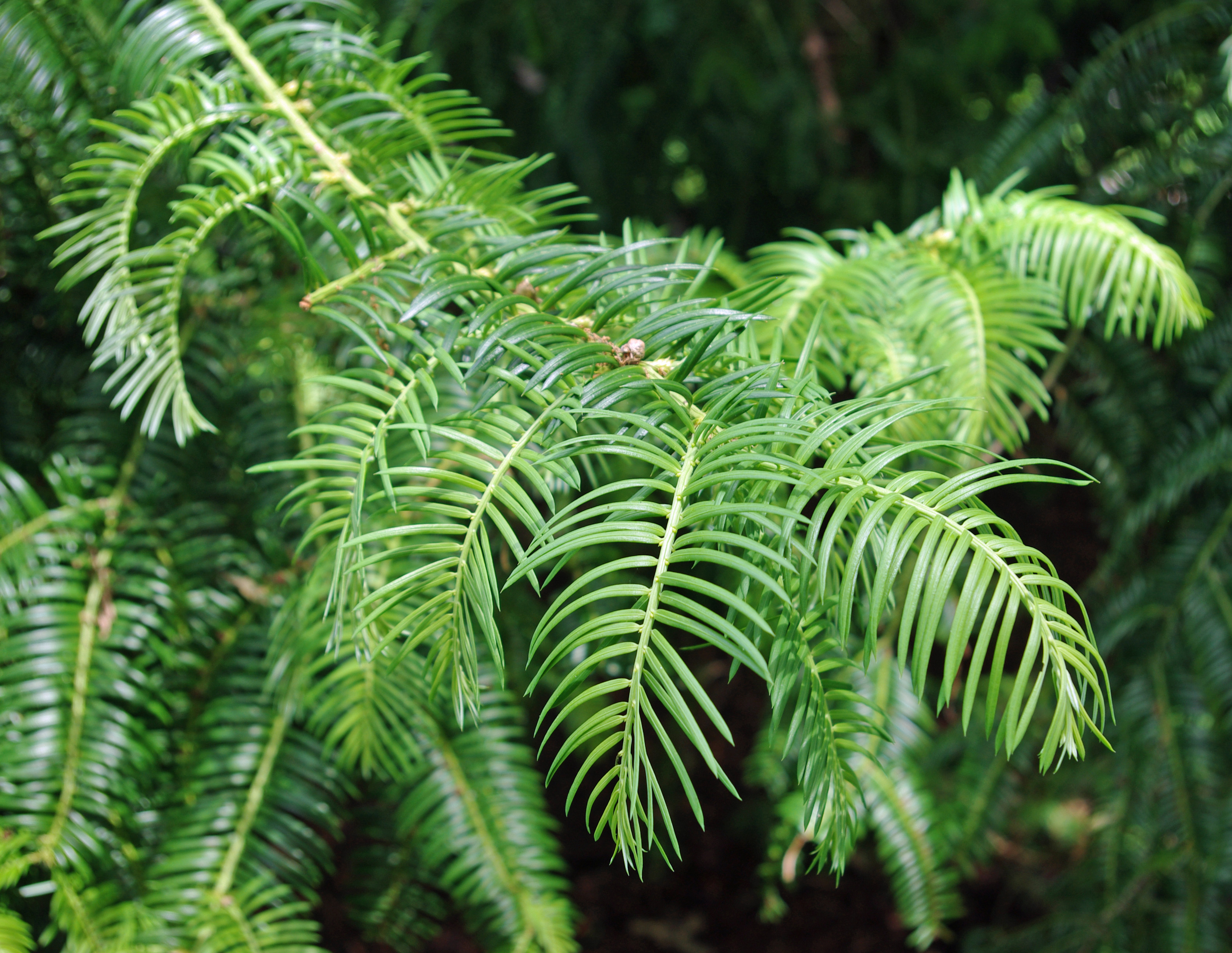Cephalotaxus sinensis
Chinese Kopfeibe ( Cephalotaxus sinensis)
The Chinese Kopfeibe ( Cephalotaxus sinensis ) is a species of the family head Yews ( Cephalotaxaceae ). It is native to eastern China and Taiwan.
- 6.1 Notes and references
Description
The Chinese can Kopfeibe grows as evergreen shrub or small tree of plant height 12-15 meters and diameter at breast height of up to 120 centimeters reach. The branches are shaped ovoid to rectangular in cross section. The tribe has a red, gray or gray -brown bark.
The soft but leathery needles straight shape with a length of 1 to 7 centimeters and a width of 2-4 mm to lanceolate. You are at a up to 2.5 mm long stalk and go more or less straight from the branches off. The base of the needles is wedge-shaped or rounded while the tip is wedge-shaped tapering to a point. The needle top is colored green and at the needle base you will find 12 to 18 white, very rare green Stomatareihen.
The heyday of the species extends from March to June, and the seeds ripen from June to November. The pink - brown male cones are spherical shaped with a diameter of 4-7 mm and are at a roughly 3 mm long stalk. They are in groups of six to seven and contain four to eleven Mikrosporophylle with two to four pollen sacs. The gray in color, female cones have a 3-8 mm long stalk and are available individually or in groups of two to eight. They are surrounded by a 1.6 to 2.5 centimeters long and 0.8 to 1.6 centimeters wide seed coat ( aril ), which is colored red or reddish purple towards maturity. On its surface it takes six, clearly pronounced longitudinal ridges. The oval to elliptical seeds are 1.8 to 2.5 inches long and 0.9 to 1.2 inches thick.
Distribution and location
The natural range of the Chinese Kopfeibe is located in eastern China and in the center and north of the island of Taiwan. In China, there parties include the provinces of South Anhui, Fujian, southern Gansu, Southwest Guangdong, Guangxi, northeast Guizhou, Henan, Hubei, Hunan, southern Jiangsu, Jiangxi, southern Shaanxi, Sichuan, Yunnan and Zhejiang Southeast. In Shandong Province, the species was cultivated for cultivation purposes.
The Chinese Kopfeibe thrives at altitudes 600-3200 m. It grows in mixed and coniferous forests and in thickets. There are soils colonized that have formed on granite, limestone or sandstone.
Use
The wood of the subspecies sinensis is used among other things for the production of furniture and tools. Furthermore, the species is also cultivated as an ornamental plant.
The branches, roots and seeds contain a variety of alkaloids that are used to fight leukemia and lymphoma.
System
The first description as Cephalotaxus sinensis var drupacea was made in 1914 by Alfred Rehder and Ernest Henry Wilson in Plantae Wilsonianae, 2 ( 1 ), pp. 3-4. 1954 described Hui Lin Li it in Lloydia, 16, p 162 as a separate species Cephalotaxus sinensis. A further synonym of Cephalotaxus sinensis ( Rehder & EHWilson ) HL Li is Cephalotaxus harringtonia var sinensis ( Rehder & EHWilson ) Rehder.
Subspecies
The Chinese Kopfeibe is divided into up to four sub- types:
- Cephalotaxus sinensis subsp. hainanensis ( H.L. Li) Silba. A synonym is Cephalotaxus hainanensis H.L. Li
- Cephalotaxus sinensis subsp. latifolia ( W. C. Cheng & Fu L.K. ) Silba. Occurs in the Chinese provinces of Fujian, Guangdong, Guangxi, Guizhou, Hubei, Jiangxi and Sichuan. A synonym is Cephalotaxus latifolia W. C. Cheng & L.K. Fu
- Cephalotaxus sinensis subsp. sinensis is the nominate
- Cephalotaxus sinensis subsp. wilsoniana ( Hayata ) Silba. Occurs on Taiwan. A synonym is Cephalotaxus wilsoniana Hayata. Molecular biological studies, however this is closely related to Cephalotaxus harringtonia the subspecies and probably as a variety of this type can be considered.
This subspecies, however, are not universally recognized. Thus, the Flora of China, there are only the two varieties sinensis and wilsonia and leads latifolia as an independent art Farjon knows no further subdivision of the kind, and leads Cephalotaxus latifolia Cephalotaxus and hainanensis as a separate species.
Threats and conservation
The Chinese Kopfeibe is " not threatened " on the Red List of IUCN. However, it is noted that a re-examination of risk is necessary.
Swell
- Template: Internet resource / maintenance / access date not in ISO format Christopher J. Earle: Cephalotaxus sinensis. In: The Gymnosperm Database. www.conifers.org, December 12, accessed on 26 December 2011 ( English).
- Liguo Fu, Nan Li & Robert R. Mill: Cephalotaxaceae. Cephalotaxus. In: Wu Zhengyi, Peter H. Raven & Hong Deyuan (eds.): Flora of China. Cycadaceae through Fagaceae. Volume 4, Science Press and Missouri Botanical Garden Press, Beijing and St. Louis in 1999, ISBN 0-915279-70-3, Cephalotaxus sinensis, S. 86 ( this printed work is the same text online, Cephalotaxus sinensis - Online).









